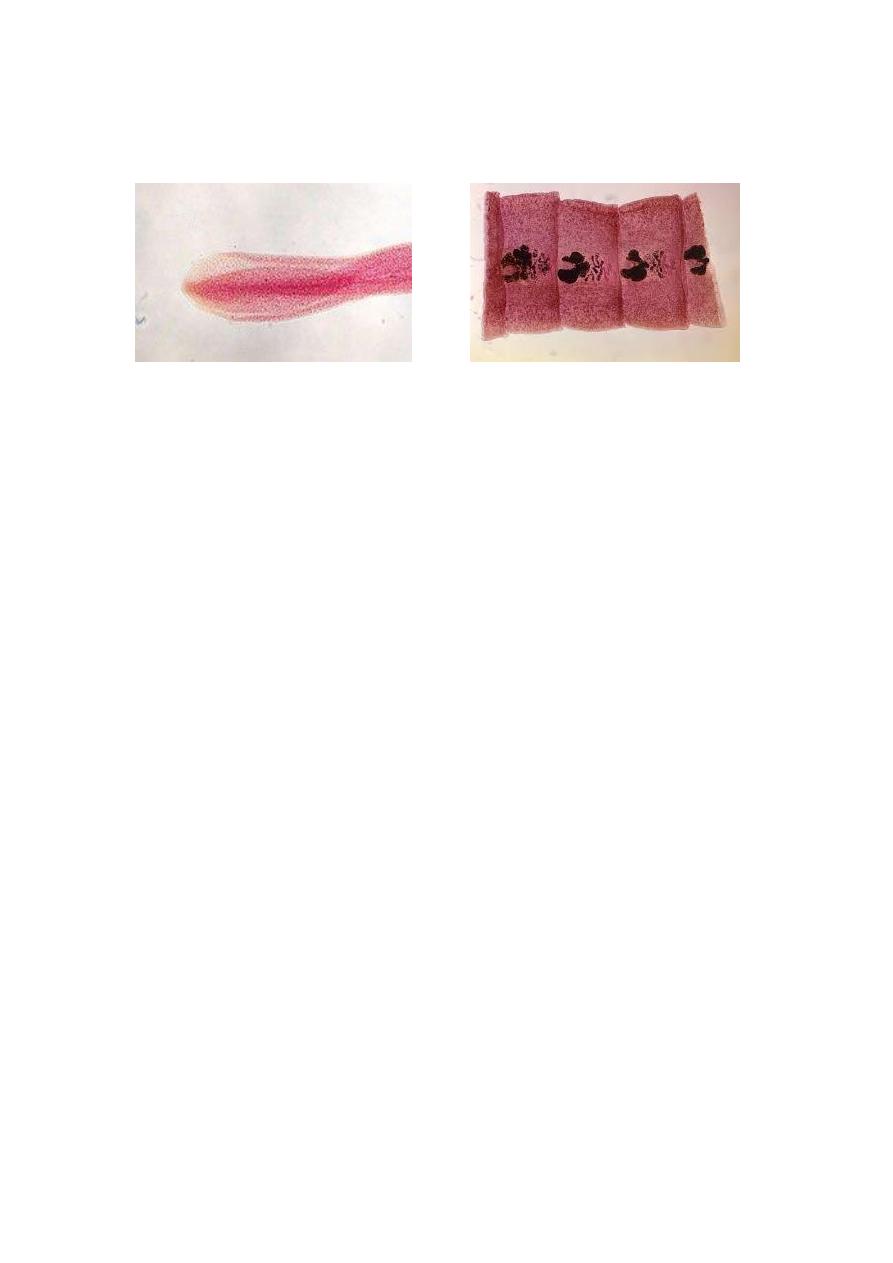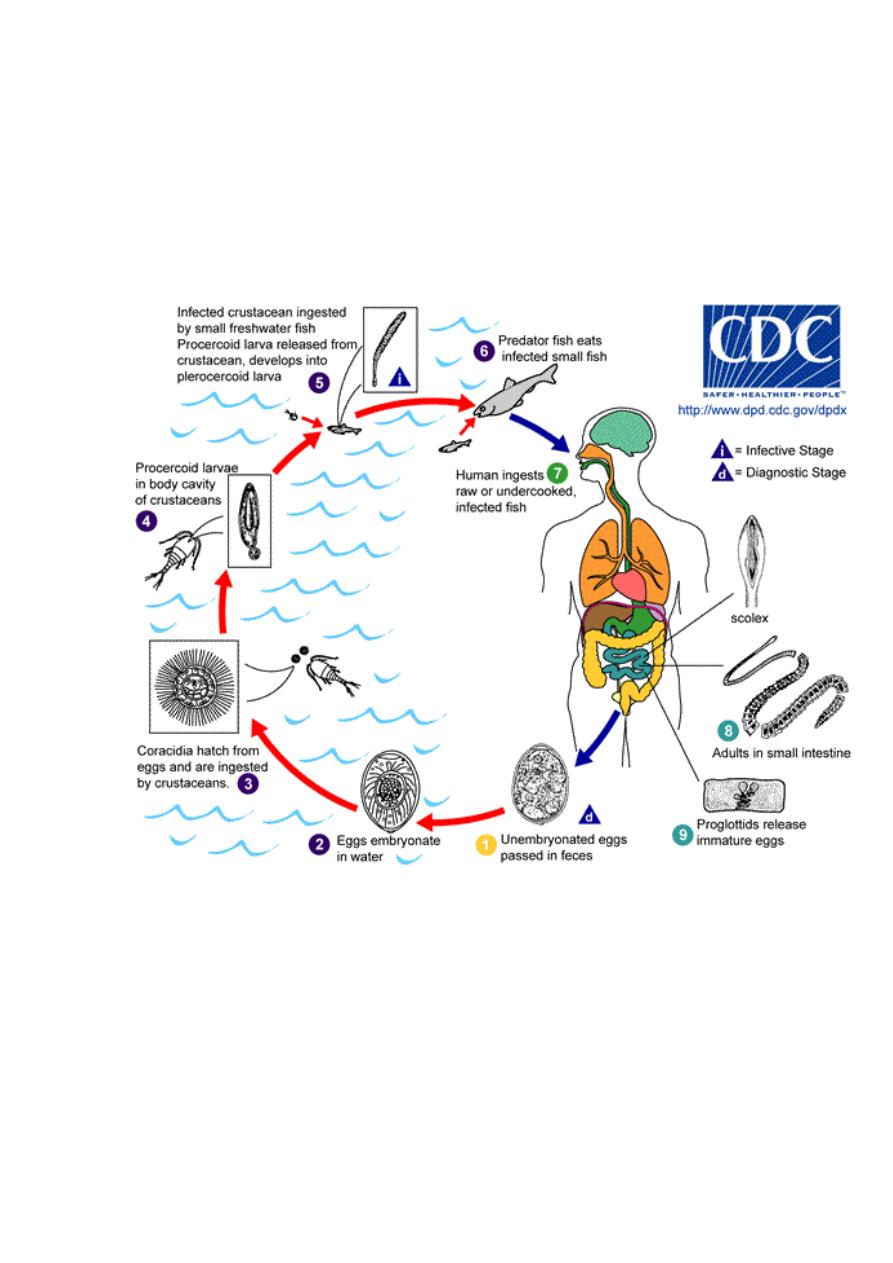
Diphyllobotherium latum
Scolex Mature proglottids
Diphyllobotherium latum (Linnaeus, 1758) Luhe, 1910 was prevalent in the Baltic
Sea area at an early.
Today D.latum is indigenous throughout many parts of Russsia, in the Baltic Sea
countries, Central and Southeastern Europe, Africa, Japan, New South Wales,
Australia, Canada, Alaska, and in lakes of southern Chile and Argentina.
Morphology, Biology and Life Cycle.
The fully developed strobila of D.latum is ivory colorded, up to 10 meters or more in
length, and has up to 4000 proglottids. The elliptical or spatulate scolex measures
about 2.5 mm in length by 1 mm in breadth, and is provided with a median ventral
and a median dorsal grooved sucker. The adjacent portion of the neck is unusually
delicate. Proglottid formation in D.latum occurs at the distal end of the neck as in
other strobilate tapeworms, but accessory proglottids are produced at all levels of the
worm.
The eggs within the fully developed uterus are continuously discharged through the
uterine pore. Terminal proglottids gradually become non-productive and disintegrate.
The egg of D.latum is unembryonated at the time it is evacuated in the host's feces, it
is broadly ovoidal, has an operculum at one end and a small inconspicuous thickening
of the shell at the opposite end. Size of the eggs varies considerably the range being
from about 60 by 40 to 70 by 50 microns.
Embryonation of eggs which reach cool fresh water (15 to 25° C.) requires 11 to 15
days. Then the embryo escape through the opened operculum and by means of its
ciliated covering swims about in the water. In order to proceed with development it
must be eaten within 12 hours by an appropriate species of water “flea” (Cyclops in
Europe, Diaptomus in North America).
Once ingested by this copepod, the embryo burrows into the hemocele and transforms
into the procercoid larva. If the infected copepod is then eaten by a fresh-water fish,
transforms into a plerocercoid larva.
Consumption of infected fish flesh by man completes the epidemiologic cycle. In
approximately 3 to 5 weeks the worm develops to maturity and egg production is
initiated.

Egg
Pathogenecity and Symptomatology
D.latum may produce no symptoms, but in approximately 50% of the infections there
are digestive disturbances, including diarrhea, heartburn, a sense of fullness in the
epigastrium, hunger pains, or loss of appetite, anorexia, nausea and vomiting.
In certain instances, there is an anemia, that so-called “bothriocephalus anemia” and
severe symptoms associated with jejunal attachment, with this investigators believed
to be responsible for an impairment of the interaction of the extrinstic and intrinsic
factors of castle. (i.e., failure to assimilate vitamin B12).
In the average case the only change in the blood picture is a moderate eosinophilia
and slight leukocytosis.
Diagnosis and Treatment
Diagnosis depends on finding the characteristic eggs in the stool or the occasionally
vomited proglottids. A single worm at the height of reproductivity may produce up to
15.000 eggs per gram of formed stool.
Treatment is similar to that recommended for Taenia saginata infection, Viz., with
praziquantel or niclosamide.
Epidemiology
Sveral epidemiologic conditions must exist before the life cycle of Diphyllobotherium
latum can be completed: (1) Eggs must be discharged into cool fresh water, where
they embryonate and hatch; (2) the emerging ciliated embryos must be eaten by
certain species of water “flea” (Diaptomus or Cyclops), in which the embryos
transforms into procercoid larvae; (3) the infected water “flea” must then be eaten by
plankton-feeding fishes, in the flesh of which the procercoids transform into the
plerocercoid larval stage, and (4) the infected fish must be eaten raw by the definitive
host (human), in the intestine of which the larvae develop into adult worms.
Although dogs, and some areas probably bears, are reservoirs of D.latum, man is
primarily responsible for establishing and maintaining the cycle in which he is
involved.

Control
Control of fish tapeworm infection in endemic areas requires (1) sanitary disposal of
human excreta so that viable eggs of D.latum do not reach bodies of fresh water in
which the intermediate hosts breed, and (2) thorough cooking of all fish obtained from
the area. Freezing at temperature of -10° C. for 48 hours also will kill the plerocercoid
larval stage.
Life Cycle of Diphyllobotherium latum
